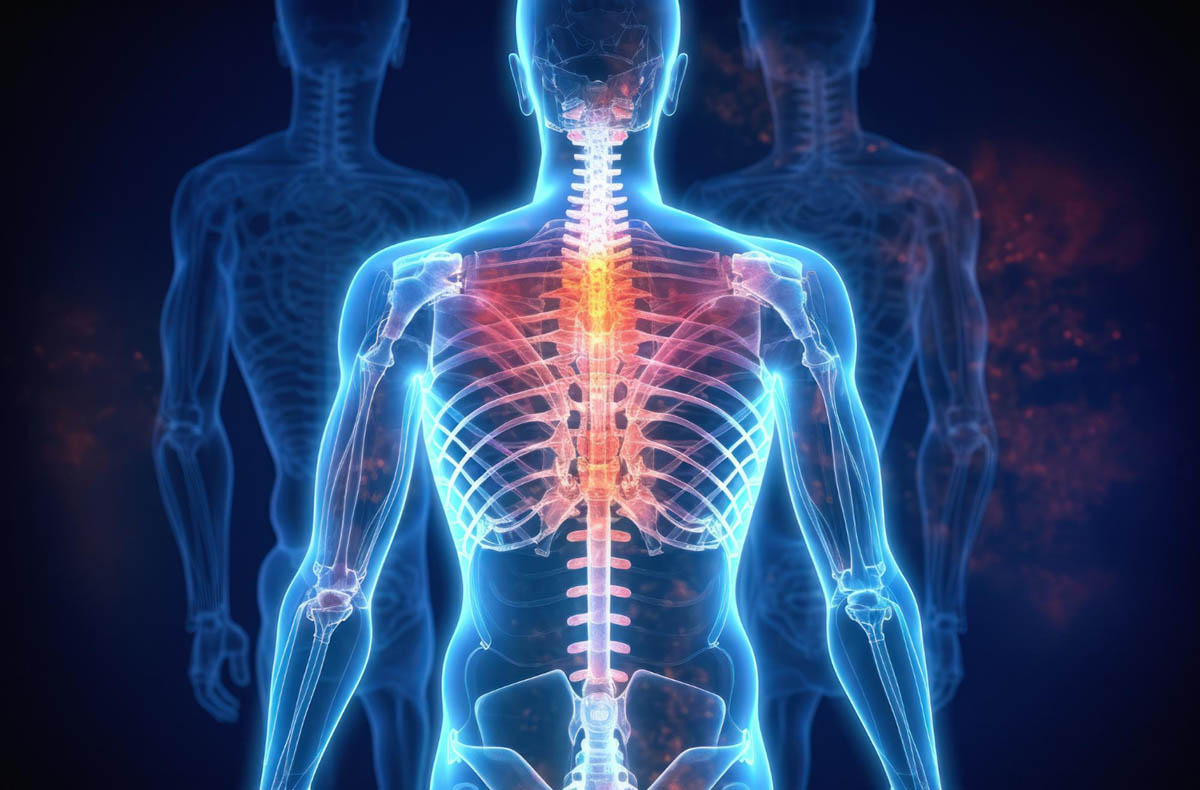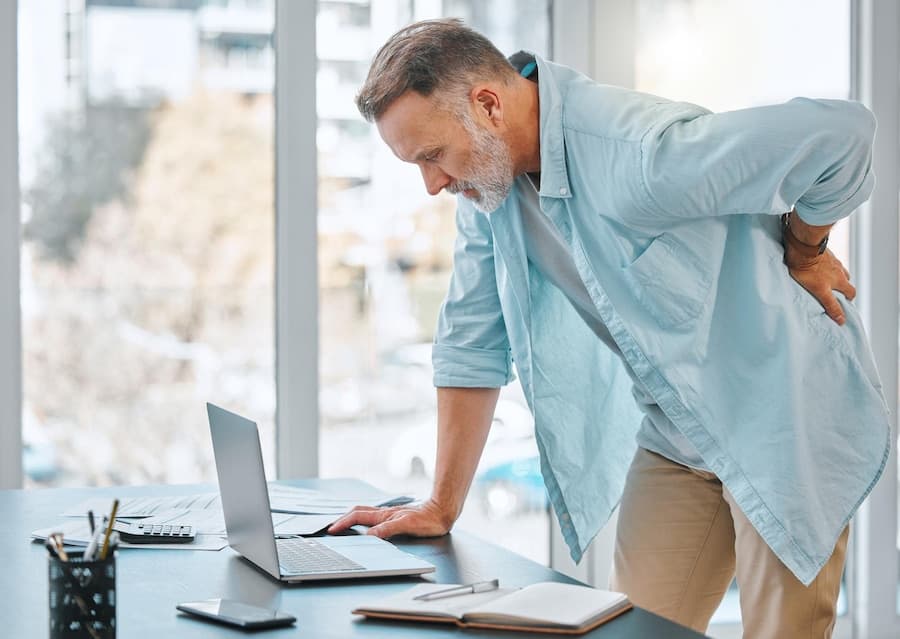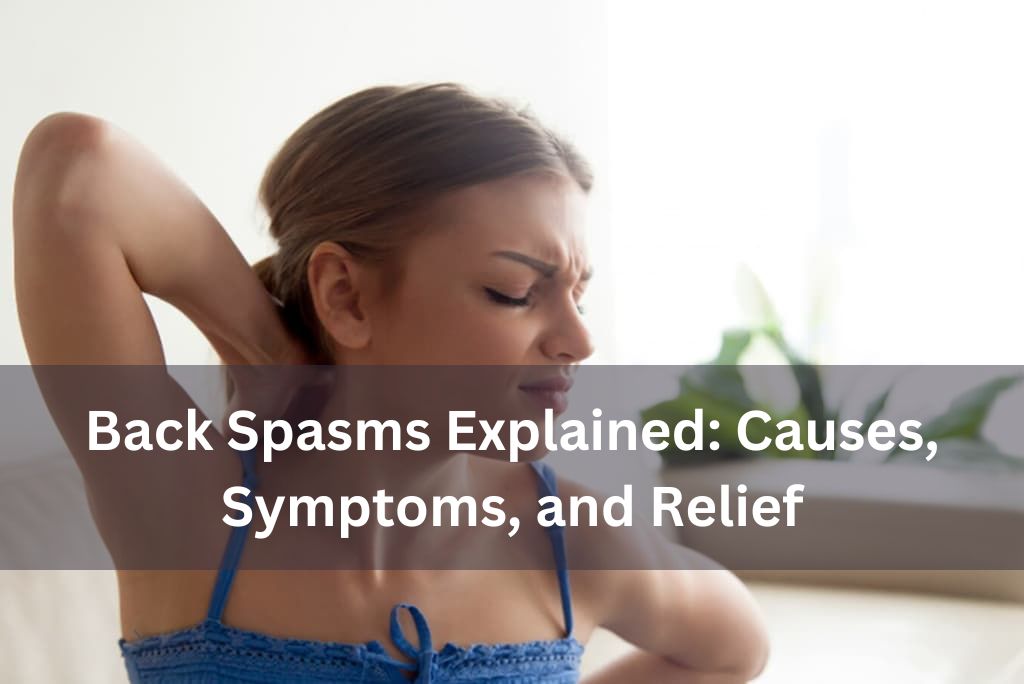Experiencing pain around the ribs and back can be both concerning and uncomfortable, affecting your daily activities and quality of life. This common condition can stem from various sources, ranging from muscle strains to more serious medical conditions. Understanding the potential causes and symptoms can help you seek appropriate treatment and find relief.
Back pain is a common issue that nearly all of us have encountered at some point. Affecting about 39% of adults in the U.S. alone, statistics indicate that approximately 619 million people worldwide suffer from back pain.
Why Do My Ribs and Back Hurt Together?
When pain occurs in both the rib area and back simultaneously, it often reflects the interconnected nature of the body’s musculoskeletal system. The thoracic region, which includes the rib cage and middle portion of the spine, functions as an integrated unit during movement and breathing.
The rib cage consists of bones, costal cartilage, and intercostal muscles that work together to protect vital organs while facilitating respiration. Each rib connects to the spine at two points—the costovertebral joints and costotransverse joints—creating a complex mechanical relationship. When dysfunction occurs at any point in this system, pain can radiate across multiple areas.
Nerves also play a crucial role in how we experience pain in this region. The spinal cord sends pain signals through nerve pathways that can make it difficult to pinpoint the exact source of discomfort. Sometimes, what feels like rib pain may actually originate from the spine, or vice versa.
Additionally, internal organs located near the rib cage may refer pain to the back when inflamed or dysfunctional, creating a confusing pattern of symptoms that requires careful diagnosis.
Back rib pain can result from various underlying conditions, such as poor posture, muscle strains, ligament sprains, joint injuries, organ-related issues, infections, osteoarthritis, scoliosis, thoracic disc or joint problems, and fibromyalgia. Common symptoms of these conditions include pain, swelling, bruising, and difficulty breathing.
What Does Pain Around the Ribs and Back Feel Like?
Common Ways Patients Describe the Pain
Patients experiencing rib and back pain often describe their symptoms in various ways depending on the underlying cause. Many report sharp pain that intensifies with motion or deep breathing. Others experience a dull aching sensation that persists throughout the day.
The pain may be localized to a specific spot or radiate across a broader area. Some individuals notice that certain movements trigger their symptoms, while others find that the discomfort remains constant regardless of activity.
Deep breaths often worsen the pain, particularly when the intercostal muscles or costal cartilage is involved. This breathing difficulty can create additional anxiety, potentially exacerbating the symptoms further.
Red Flags That It Might Be More Than Muscle Pain
While many cases of rib and back pain stem from musculoskeletal conditions, certain symptoms suggest more serious underlying conditions:
- Severe pain that wakes you at night or prevents sleep
- Shortness of breath or difficulty breathing that accompanies the pain
- Persistent pain that doesn’t improve with rest or over-the-counter pain relievers
- Numbness in legs or other areas away from the initial pain site
- Unexplained weight loss or fever occurring alongside the pain
- Chest pain or intense chest pressure, particularly if accompanied by an irregular heartbeat
- Pain worse when lying down or that doesn’t respond to changes in posture
These symptoms may indicate more serious health conditions requiring immediate medical attention.
Musculoskeletal Causes of Rib and Back Pain
Intercostal Muscle Strain
The intercostal muscles run between the ribs and help facilitate breathing and trunk movement. When these muscles become strained through overuse, sudden movements, or repetitive activity, they can cause acute pain along the rib cage. Intercostal muscle strain often produces pain that worsens with deep breathing, laughing, or twisting motions.
Poor Posture and Muscle Imbalances
Poor posture places excessive stress on the spine and supporting structures. Over time, this can lead to muscle tension in the upper body, particularly between the shoulder blades and around the rib cage. Posture improvement exercises can help alleviate this common condition.
Joint Dysfunction and Sprains
The joints connecting the ribs to the spine can become dysfunctional or sprained. This condition often produces pain that may mimic more serious disorders. When the costochondral joints (where ribs meet the sternum) or costotransverse joints become inflamed, movement and breathing can become painful.
Degenerative Spine Conditions (Herniated Discs, Spondylosis)
Disc herniation in the thoracic disc region can compress nerves that wrap around the rib cage, causing pain that radiates from back to front. Degenerative disc disease affects the shock absorbers between vertebrae, potentially leading to nerve compression and chronic discomfort.
Slipping Rib Syndrome & Twelfth Rib Syndrome
Rib syndrome occurs when the cartilage segments connecting the lower ribs become loose, allowing excessive rib motion that irritates surrounding tissues. Twelfth rib syndrome specifically affects the lowest “floating” ribs, which lack anterior attachments. Both conditions can cause pain in the lower back and rib areas.
Bruised or Broken Ribs
Direct trauma to the chest wall can result in bruised or broken ribs. A broken bone in this area causes intense pain, especially with breathing or movement. Even minor injuries can create significant discomfort due to the constant motion of the rib cage during respiration.
Costochondritis
Costochondritis is inflammation of the cartilage that connects the ribs to the breastbone (chest bone). This painful condition mimics the symptoms of heart disease but is actually a musculoskeletal issue. The pain typically worsens with physical activity and deep breathing.
Iliocostal Friction Syndrome
When the lower ribs rub against the pelvis during certain movements, it can cause pain known as iliocostal friction syndrome. This condition is most common in people with certain body types or those who engage in activities requiring significant trunk flexion.
Internal Organ Conditions That Can Trigger Rib and Back Pain
Gallbladder Issues (Gallstones, Inflammation)
Gallbladder problems can refer pain to the right upper back and ribs. This pain often comes in waves and may be accompanied by digestive symptoms.
Liver Disorders (e.g., Hepatitis, Liver Inflammation)
Inflammation or enlargement of the liver can create pressure against the rib cage and cause pain in the right upper quadrant that may radiate to the back.
Gastrointestinal Causes (Pancreatitis, GERD, Ulcers)
Conditions affecting the digestive system, including acid reflux and inflammatory bowel disease, can manifest as pain in the lower ribs and mid-back. A peptic ulcer may also cause referred pain to this region.
Kidney Infections or Stones
A kidney infection can cause pain that radiates from the back to the ribs. The pain is often accompanied by fever and urinary symptoms. Kidney stones may cause excruciating pain that fluctuates in intensity.
Lung Conditions (Pneumonia, Pleurisy, Pulmonary Embolism)
Respiratory conditions like acute bronchitis or chronic bronchitis can cause pain around the ribs due to persistent coughing and inflammation. Pneumonia often causes pain with breathing, while a pulmonary embolism (blood clot in the lung) represents a medical emergency requiring immediate treatment.
Lung Tumors or Masses
Growths in the lungs can press against the pleura (lung lining) or rib cage, causing persistent pain that may worsen over time. These conditions typically require comprehensive medical treatment.
Other Medical Conditions to Consider
Fibromyalgia
This chronic condition increases sensitivity to pain throughout the body, including the chest wall and back. Fibromyalgia pain often feels like deep muscle aches and may be accompanied by muscle spasm, muscle stiffness, and muscle weakness.
Osteoporosis
Weakened bones due to osteoporosis can lead to compression fractures in the spine, causing back and rib pain, particularly in older adults.
Shingles (Herpes Zoster)
This viral infection causes a painful rash that often wraps around one side of the rib cage from back to front, following nerve pathways. The pain may begin before the rash appears.
Degenerative Scoliosis
Curvature of the spine can place uneven pressure on the ribs and back muscles, leading to chronic pain and reduced range of motion.
Autoimmune Inflammatory Disorders (e.g., Ankylosing Spondylitis)
Certain rheumatic diseases can cause inflammation at the points where tendons and ligaments attach to bones, including the rib cage and spine.
Intercostal Neuralgia or Nerve Compression
Damage to the nerves that run between the ribs can cause sharp, shooting pain along their path. Peripheral nerve compression may result from injury, infection, or other underlying conditions.
Can Lifestyle Habits Be Contributing to the Pain?
Sedentary Behavior and Poor Ergonomics
Extended periods of sitting with improper posture can strain the muscles supporting the rib cage and spine. Over time, this leads to muscle imbalances and pain.
Repetitive Motion or Heavy Lifting
Certain occupations or activities that require repetitive motions or lifting heavy objects can strain the muscles and joints of the thoracic region, leading to pain.
Chronic Stress and Muscle Tension
Psychological stress often manifests physically as muscle tension, particularly in the shoulders, neck, and upper back, which can radiate to the ribs.
Obesity or Deconditioning
Excess body weight places additional strain on the spine and supporting structures. Lack of physical activity reduces muscle strength needed to maintain proper posture and spinal alignment.
When Should You Worry About Rib and Back Pain?
Emergency Symptoms That Require Immediate Help
Seek emergency medical attention if you experience:
- Severe chest pain accompanied by shortness of breath, sweating, or nausea
- Pain following significant trauma
- Intense pain with rapid breathing and bluish discoloration of lips or extremities
- Sudden, severe pain with a history of blood clots or pulmonary embolism
Persistent or Worsening Pain
If your rib pain persists beyond two weeks despite conservative therapy, consult your healthcare provider. Chronic pain that gradually worsens may indicate a progressive condition requiring treatment.
Pain With Breathing or Swallowing
Difficulty breathing or pain when swallowing warrants prompt medical evaluation, as these symptoms could indicate involvement of the lungs or digestive tract.
Symptoms Suggesting Organ Involvement
Rib and back pain accompanied by jaundice, blood in urine, persistent cough with blood in sputum, or changes in bowel movement patterns should be evaluated promptly.
How Doctors Diagnose the Root Cause
Medical History and Physical Exam
A healthcare professional will begin with a thorough physical exam and review of your medical history. They’ll assess the location and quality of pain, as well as any factors that worsen or improve your symptoms.
Imaging: X-rays, MRI, CT scans
X-rays can reveal bone abnormalities or fractures. MRI provides detailed images of soft tissues, while CT scans offer comprehensive views of both bone and soft tissue structures. These imaging studies help identify structural causes of pain.
Lab Tests: Blood work, urinalysis, liver/kidney panels
Blood tests may detect inflammation, infection, or organ dysfunction. Elevated white blood cell counts might indicate infection, while specific markers can point to rheumatic diseases or other inflammatory conditions.
Specialist Referrals (Orthopedic, Gastroenterology, Pulmonology, Neurology)
Depending on the suspected cause, your provider may refer you to specialists for accurate diagnosis and specialized treatment plans.
How to Relieve Rib and Back Pain
At-Home Remedies (Rest, Ice/Heat, Posture Correction)
For minor injuries or muscle strains:
- Apply ice for acute pain (first 48 hours)
- Use a heating pad for chronic pain
- Rest the affected area while maintaining gentle movement
- Use cold compresses or a cold pack to reduce inflammation
- Practice posture improvement techniques
Over-the-Counter and Prescription Medications
- Counter pain relievers like NSAIDs reduce inflammation and discomfort
- Muscle relaxants may help with muscle spasm and tension
- For severe cases, prescription pain medicines may be necessary
- Always discuss current medications with your healthcare provider before starting new ones
Physical Therapy and Corrective Exercises
Physical therapy can be immensely beneficial for musculoskeletal causes of rib and back pain. A physical therapist can design a program targeting specific issues while choosing the right physical therapist is crucial for optimal results.
Therapy may include:
- Gentle exercises to improve flexibility
- Strengthening exercises for core and back muscles
- Manual therapy techniques
- Benefits of Physical Therapy include improved function and reduced pain without medications
For those concerned about costs, affordable care options for physical therapy are available in many communities.
Injections (Corticosteroids, Nerve Blocks)
For persistent pain, injections may provide relief:
- Steroid injections reduce inflammation
- Facet injections target specific spinal joints
- Regenerative medicine approaches like bone marrow concentrate injections show promise in tissue repair
- Nerve blocks can interrupt pain signals
Surgical Options (for severe structural causes)
Surgery is typically reserved for cases that don’t respond to conservative therapy. Surgical interventions address specific structural problems like disc herniation or spinal deformities.
Preventing Rib and Back Pain in the Future
Improve Posture and Ergonomics
Maintaining proper alignment reduces stress on the rib cage and spine:
- Be mindful of your sitting and standing posture
- Set up workstations with ergonomic principles in mind
- Take regular breaks from prolonged sitting
Strengthen Core and Spine-Stabilizing Muscles
A strong core supports the spine and reduces strain on the rib cage:
- Simple Back Exercises at Home for Better Posture can be done daily
- Focus on exercises that promote spinal stability
- Include stretches for intercostal muscles and shoulder mobility
Maintain Healthy Weight and Stay Active
Extra weight puts additional strain on the musculoskeletal system:
- Regular physical activity improves blood circulation and promotes healing
- Choose low-impact activities if you have existing pain
- Maintain a balanced diet to support connective tissue health
Manage Stress and Sleep Quality
Psychological well-being affects physical comfort:
- Practice stress reduction techniques
- Ensure adequate sleep on a supportive mattress
- Consider mind-body approaches like yoga or meditation to reduce muscle tension
Final Thoughts: Don’t Ignore Persistent Rib or Back Pain
While many cases of rib and back pain stem from minor injuries or muscle strain, persistent discomfort warrants medical attention. The thoracic region houses many vital organs and complex structures, making proper diagnosis essential.
Pay attention to warning signs like pain that disrupts sleep, affects breathing, or occurs alongside systemic symptoms. Early intervention can prevent the development of pain becoming a chronic condition that impacts your daily life.
Remember that treatment approaches vary based on the underlying cause. Working with your healthcare provider to identify the root issue is the first step toward effective pain management and restoration of function. Whether your symptoms require simple rest and over-the-counter remedies or more advanced treatment from a medical provider, addressing rib and back pain promptly leads to better outcomes.
Frequently Asked Questions
What does it mean when your rib cage and back hurts?
Pain in both the rib cage and back often indicates a musculoskeletal issue affecting the thoracic region. Common culprits include intercostal muscle strain, costochondritis, poor posture, or rib syndrome. However, it can also signal problems with internal organs like the lungs, kidneys, or digestive system. If pain persists or is accompanied by other symptoms, consult a healthcare professional for proper diagnosis.
How to tell if back pain is muscle or organ?
Muscle pain typically worsens with movement and may feel better with rest or position changes. It often feels like a deep ache or stabbing sensation that responds to massage or stretching. Organ pain tends to be less affected by movement and may be accompanied by other symptoms specific to the affected organ, such as fever, nausea, changes in urination or bowel habits, or jaundice. Organ pain might also follow patterns like coming in waves or occurring after certain activities like eating.
What organ is behind the right rib in the back?
Several organs lie beneath the right rib cage extending toward the back, including the liver (uppermost portion), the right kidney, part of the large intestine, and a portion of the right lung. The gallbladder also sits under the right rib cage but more toward the front. Pain in this region could originate from any of these organs or from the surrounding muscles, nerves, or bones of the rib cage itself.
Can anxiety really cause rib and back pain?
Yes, anxiety can cause physical symptoms including rib and back pain. During periods of stress or anxiety, muscles often tense unconsciously, particularly in the chest, shoulders, and back. This muscle tension can lead to aches, spasms, and discomfort around the rib cage and spine. Additionally, anxiety may cause rapid breathing or hyperventilation, which can strain the intercostal muscles and create chest wall pain that mimics more serious conditions.
How do I treat rib and back pain naturally?
Natural approaches to managing rib and back pain include gentle stretching exercises to improve flexibility, applying heat for chronic pain or ice for acute injuries, maintaining good posture, practicing stress-reduction techniques like deep breathing, and ensuring adequate rest. Yoga and tai chi can improve posture and reduce tension in the thoracic region. Anti-inflammatory foods may help reduce inflammation, while staying hydrated supports tissue repair. However, persistent or severe pain should be evaluated by a healthcare provider before relying solely on natural remedies.
James Foster, PT is a licensed physical therapist with over 11 years of hands-on experience in helping individuals improve mobility and live pain-free. As a health writer, James shares expert advice, rehabilitation strategies, and wellness tips to empower readers toward healthier, stronger lives.



